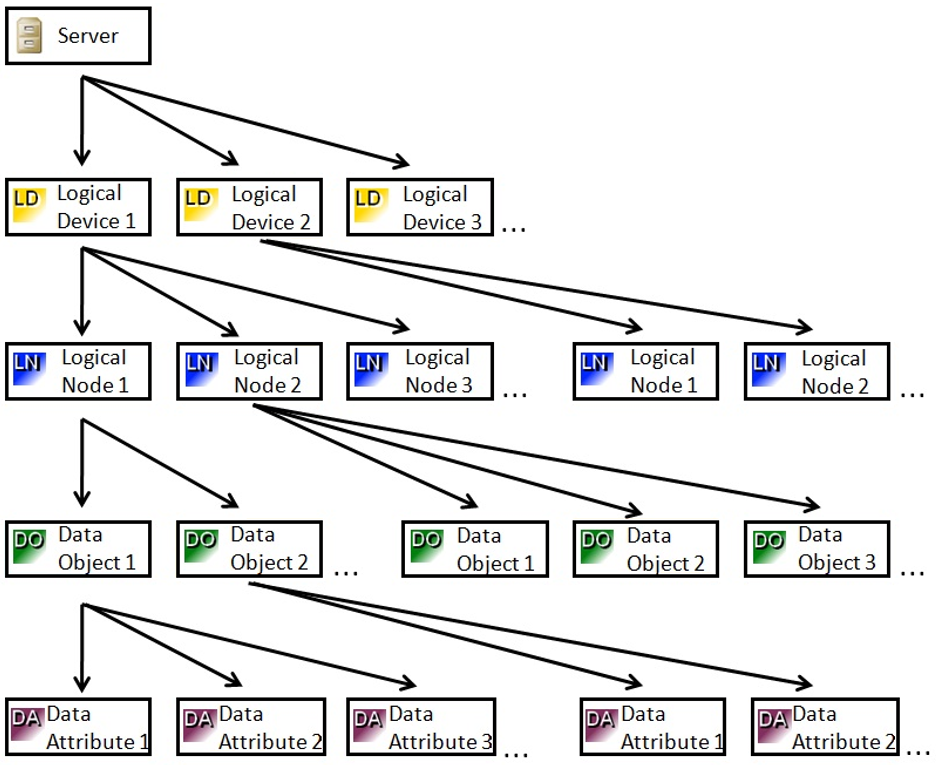Data model
IEC 61850 is the basic standard for various application specializations. Each specialization defines its own data model or extends the basic data model of IEC 61850.
Standard | Data models |
|---|---|
IEC 61850 | Basic data models for protective and control equipment in electrical substations |
IEC 61850-7-410 (former: IEC 62344) | Data models for communication in hydroelectric power plants |
IEC 61850-7-420 (former: IEC 62350) | Data models for distributed/decentralized power generation and storage |
IEC 61400-25 | Data models for the communication and monitoring of wind turbines |
In principle, the data models are divided into five hierarchical levels. The corresponding standards specify all necessary Logical Nodes, Data Objects and Data Attributes. Depending on the application, Logical Devices or server/client must be configured on the basis of the defined models. In the associated Beckhoff product, the configuration can be done in the TwinCAT Telecontrol Configurator tool.

Hierarchical levels
| The server forms the first hierarchical level in the data model of IEC 61850 or IEC 61400-25 respectively. The server offers a connection point for a device, allowing corresponding Ethernet-based communication systems to be connected. In this case TwinCAT, with the libraries belonging to the protocol, would represent such a server on an Industrial PC or embedded device. |
| The Logical Devices form the second hierarchical level in the data model of IEC 61850 and IEC 61400-25. This level subdivides a single physical device into several separate parts known as Logical Devices. The advantage of this subdivision is that functions or objects that belong together can be placed together on account of their commonalities and, for example, switched to a different operation mode. Different Logical Nodes from the third hierarchical level can be implemented, depending on the device. |
| The Logical Nodes form the second hierarchical level in the data model of IEC 61850 and IEC 61400-25. They represent the information of all conceivable sub-functions that can occur in digital station control technology and, among other things, in wind turbines. These include all protective functions as well as automation functions and functions for the processing of measured values and counter values. For all standardized IEC 61850 and IEC 61400-25 Logical Nodes there are defined identifiers that always consist of an abbreviation with four letters. For example, the abbreviation XSWI stands for Circuit Switch. A Logical Device may consist of several such nodes. |
| A Logical Node can consist of several Data Objects, which form the fourth hierarchical level of the IEC 61850 or IEC 61400-25 data model. A special feature of this hierarchical level is that data objects in turn can be hierarchically nested. For instance, a data object can consist of several sub-data objects before a basic or complex data type is ultimately accessed in a Common Data Class (CDC). |
| The data attributes form the lowest hierarchical level of IEC 61850 and IEC 61400-25. They represent the detailed information or values of the data objects. Since the same number of data attributes is always defined for many data objects, the attributes of an object are combined in so-called Common Data Classes (CDC). The associated CDC is specified for each data object; the data objects are therefore specializations of the CDC. |
 Server
Server  Logical Device
Logical Device  Logical Node
Logical Node  Data Object
Data Object  Data Attribute
Data Attribute